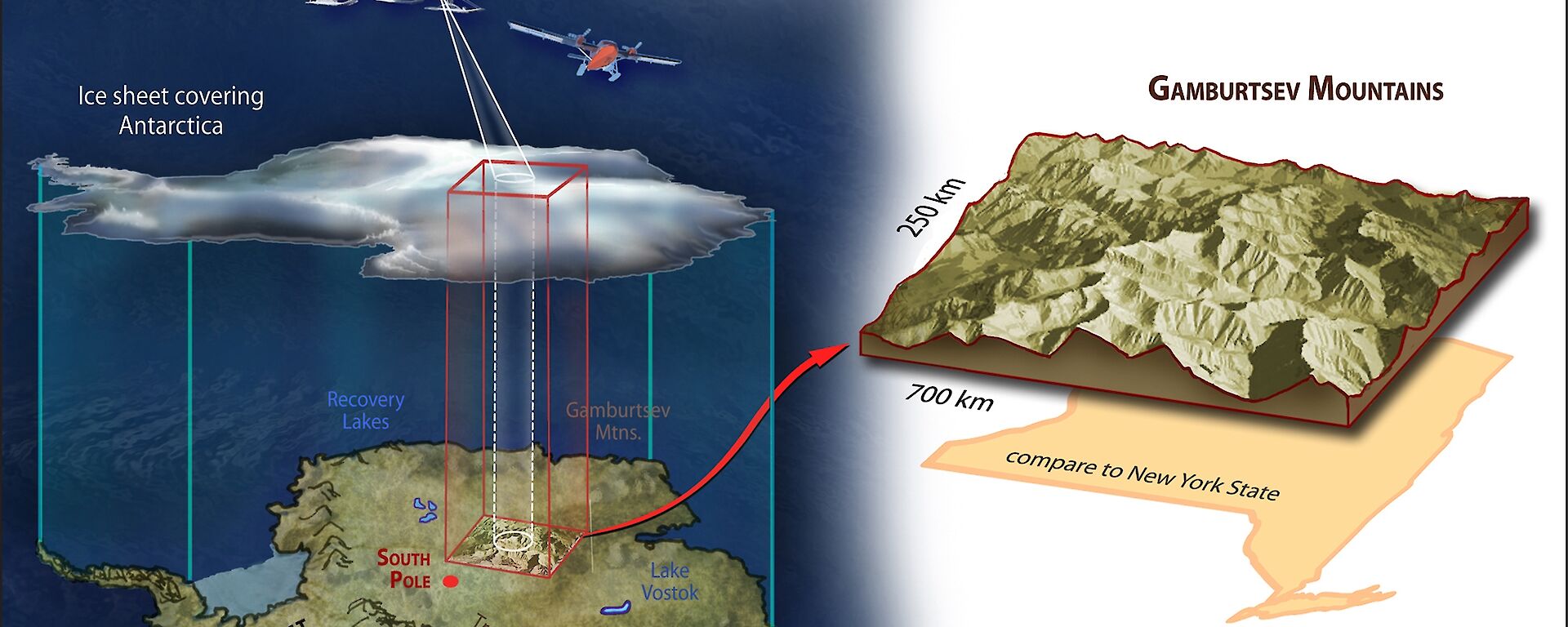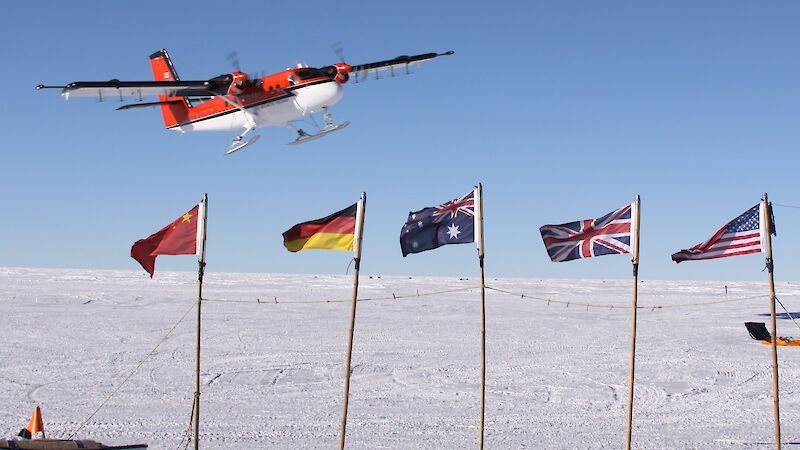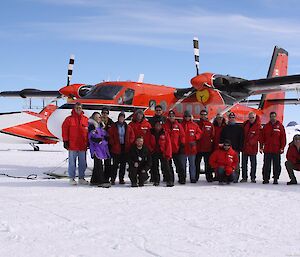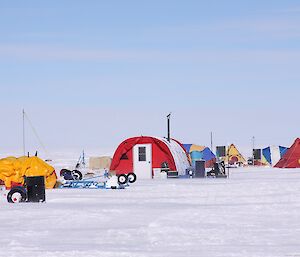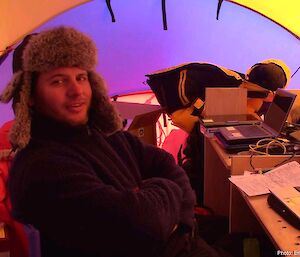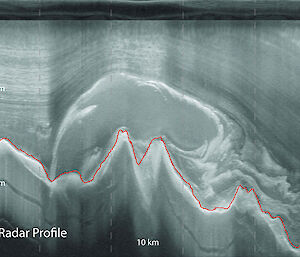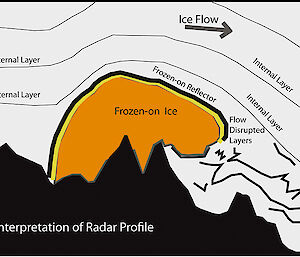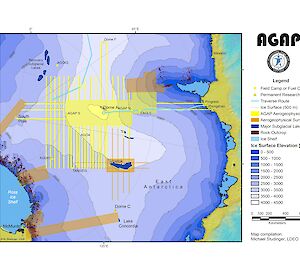During the International Polar Year (2007–09) the Australian Antarctic Division provided logistic support to an ambitious project that aimed to visualise the subglacial Gamburtsev Mountains, which in some places are buried under 3000m of ice.
Australia supported ‘Antarctica’s Gamburtsev Province Project’ (AGAP) by running a field camp — AGAP North — from which two aircraft, racked with geophysical instruments, flew survey lines over the hidden mountain range. Surveys were also conducted from a second camp — AGAP South — run by the United States.
In March this year AGAP scientists published their startling results in the journal Science; liquid water locked deep under the Antarctic ice sheet regularly thaws and refreezes to the bottom, contributing more than half the thickness of the ice sheet in places and actively modifying its structure.
Following is an edited version of a story by science writer David Funkhouser of Lamont-Doherty Earth Institute (one of the scientific institutions participating in AGAP), which describes the discovery and its importance.
Scientists working in the remotest part of Antarctica have discovered that liquid water locked deep under the continent’s coat of ice regularly thaws and refreezes to the bottom, creating as much as half the thickness of the ice in places, and actively modifying its structure. The finding, which turns common perceptions of glacial formation upside down, could reshape scientists’ understanding of how the ice sheet expands and moves and how it might react to warming climate. The study, published in the journal Science in March, is part of a six-nation study of the Gamburtsev Mountains, which lie buried under as much as 3000m of ice.
Ice sheets are well known to grow from the top as snow falls and builds up annual layers over thousands of years. But until recently, scientists have known little about the processes going on far below. In 2006 researchers in the current study showed that lakes of liquid water underlie widespread parts of Antarctica. In 2008–09 they mounted an expedition using geophysical instruments to create 3-D images of the 1200 km-long, 3400 m-high Gamburtsev Mountain range. The expedition also captured detailed images of the overlying ice and subglacial water.
‘We usually think of ice sheets like cakes—one layer at a time added from the top. This is like someone injected a layer of frosting at the bottom—a really thick layer,’ says project co-leader Professor Robin Bell, a geophysicist at Columbia University’s Lamont-Doherty Earth Observatory.
‘Water has always been known to be important to ice sheet dynamics, but mostly as a lubricant. As ice sheets change we want to predict how they will change. Our results show that models must include water beneath.’
The scientists found that refrozen ice makes up 24% of the ice sheet base around Dome A — a 4.2km-high plateau that sits over part of the Gamburtsev range and forms the high point of the East Antarctic ice sheet. In places, slightly more than half the ice thickness appears to have originated from the bottom, not the top. Here, rates of refreezing are greater than surface accumulation rates. The researchers suggest that such refreezing has been going on since East Antarctica became encased in a large ice sheet some 32 million years ago. They may never know for sure — the ice is always moving from the deep interior toward the coast, so ice formed millions of years ago, and the evidence it would carry, is long gone.
Deeply buried ice may melt because overlying layers insulate the base, trapping in heat created by friction or radiating naturally from underlying rock. When the ice melts, refreezing may take place in multiple ways. If it collects along mountain ridges and heads of valleys, where the ice is thinner, low temperatures penetrating from the surface may refreeze it. In other cases, as water gets squeezed up valley walls the pressure exerted on it changes rapidly. At depths, water remains liquid even when it is below the normal freezing point, due to the pressure exerted on it by the overlying ice. But once it moves up to an area of less pressure, the supercooled water can freeze almost instantly. Images produced by the researchers show that the refreezing deforms the ice sheet upward (see radar image).
‘When we first saw these structures in the field we thought they looked like beehives and were worried they were an error in the data,’ says Professor Bell.
‘As they were seen on many survey lines, it became clear that they were real. We did not think that water moving through ancient river valleys beneath more than one mile of ice would change the basic structure of the ice sheet.’
Because the ice is in motion, understanding how it forms and deforms at the base is critical to understanding how the sheets will move, particularly in response to climate changes.
‘It’s an extremely important observation for us because this is potentially lifting the very oldest ice off the bed,’ says Professor Jeff Severinghaus, a geologist at Scripps Institution of Oceanography in San Diego who was not involved in the study.
He says it could either mean older ice is better preserved or it could ‘make it harder to interpret the record, if it’s shuffled like a deck of cards.’
The research was conducted between November 2008 and January 2009 from two base camps around Dome A; AGAP South, run by the United States, and AGAP North, run by the Australian Antarctic Division. Using aircraft equipped with ice penetrating radars, laser ranging systems, gravity meters and magnetometers, they flew low-altitude transects back and forth over the ice to draw 3-D images of what lay beneath. The aim was to understand how the mountains arose and to study the connections between the peaks, the ice sheet, and subglacial lakes. They were also hunting for likely spots where future coring may retrieve the oldest ice.
‘Understanding these interactions is critical for the search for the oldest ice and to better comprehend subglacial environments and ice sheet dynamics,’ says Dr Fausto Ferraccioli of the British Antarctic Survey, who led the project from AGAP North.
‘Incorporating these processes into models will enable more accurate predictions of ice sheet response to global warming and its impact on future sea-level rise.’
The researchers now will look into how the refreezing process acts along the margins of ice sheets, where the most visible change is occurring in Antarctica. Based on their data, a Chinese team also hopes to drill deep into Dome A in the next two or three years to remove cores that would trace long-ago climate shifts. They hope to find ice more than a million years old.
DAVID FUNKHOUSER
Lamont-Doherty Earth Institute
AGAP at a glance
- Two camps (North and South) were established deep in the Antarctic interior around the plateau region known as Dome A.
- Aircraft used ice-penetrating radar to detect ice thickness and layering, and mapped the shape of the deeply buried bedrock.
- The planes also conducted gravity and magnetic surveys to glean more information about the mountains’ structure.
- By listening to seismic waves passing through the range, scientists could probe rock properties deep in the Earth.
- The Gamburtsev range is totally hidden by ice. In some places that ice covering is more than 3000m thick.
- One goal of the study was to find a location to drill ancient ice — ice made from snow that has accumulated over a million years.
- The oldest ice drilled so far comes from Dome C. It records climate conditions 800 000 years into the past.

